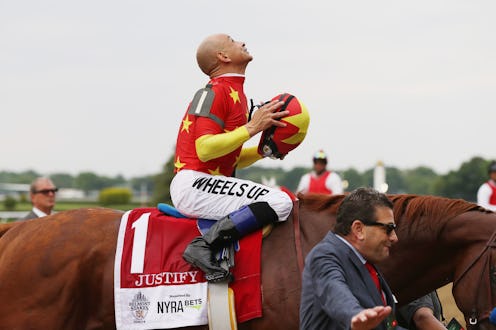News
No, The Triple Crown Doesn't Involve An Actual Crown. But Here's What It Does Include.

June 9 wasn't just any old Saturday in the world of horse racing. That day, Justify became the 13th horse ever to win the Kentucky Derby, Preakness States, and Belmont Stakes all within the same year. Naturally, since the trio of victories is known as the Triple Crown prize, an actual crown for Justify seems in order. However, that's not exactly how it works.
By the looks of it, there's not any sort of prize reserved for the Triple Crown winner. Instead, the winning horse and its team get to enjoy the money and fame earned in each of the three races prior. And, in case you're wondering, those prizes come out to a hefty sum. So sure, there doesn't seem to be any actual crown involved (the horse probably wouldn't enjoy that anyway), but the winner does not go home empty-handed. In fact, according to Time, the total prize from all three races ends up totaling just under $3 million.
On top of that, winning these races opens up opportunities for other money-making ventures. For example, as Time explains, 2015 Triple Crown winner Pharaoh was bred following his victories, and now, his owners have made much more selling the foals he fathered than they did for winning nine separate races in 2015. Pharaoh brought home nearly $9 million in victory money, and the farm that owns the right to breed him has since made $200 million selling his offspring, Time notes.
Jockeys actually lead the horse over the finish line, but they don't make as big a chunk of the prize money as you might expect. According to Time, a jockey earns around 10 percent of the prize money from each race. So, in the Belmont Stakes, jockey Mike Smith likely took home around $80,000 — still a nice chunk of change. However, not even jockeys are exempt from paying taxes on those earnings. By Time's estimations, that means Smith got something closer to $50,000 for victories in the third leg of the Triple Crown.
Though Triple Crown winners continue to rake in the money long after that year's race season ends, one question remains: Why is it called the Triple Crown if no physical crown is handed out? The term was actually dubbed by two news organizations. Though the Daily Racing Form's Charles Hatton used it, the New York Times claims it is the publication that actually popularized the term. The excerpt written for the Times by Government Law Center of Albany Law School Executive Director Bennett Liebman, who also happens to be a horse race historian, helps explain the context of its origins:
The Times first used “triple crown” to describe the Derby, Preakness, and Belmont in 1923 at a time when Hatton was at most 17 years old. The Times wrote in a year where the Preakness preceded the Derby, “Thomas J. Healey had Walter J. Salmon’s Preakness winner, Vigil, and his owner wired today that he would be here” — in Louisville, Ky. — “Friday to see his colt try to capture his second classic in the triple crown of the American turf.”
Unless a secret crown is given to the winner in private, the title is entirely figurative. Even so, the notoriety the horse, jockey, and horse owners gain by scoring the Triple Crown beats a real-life crown any day.